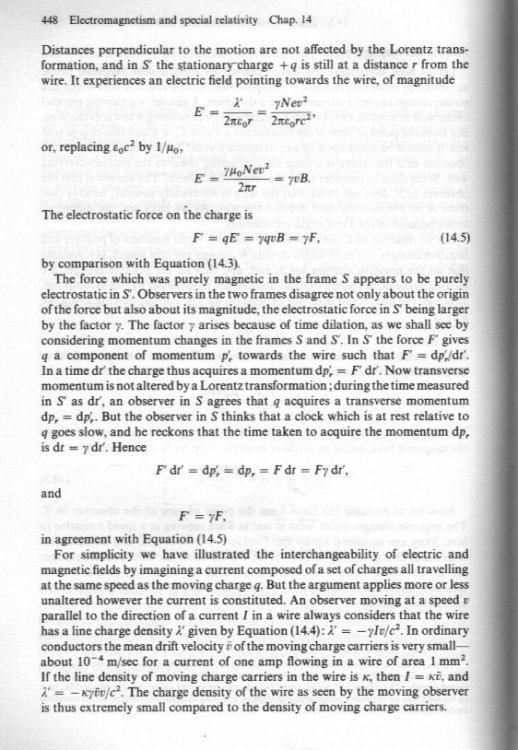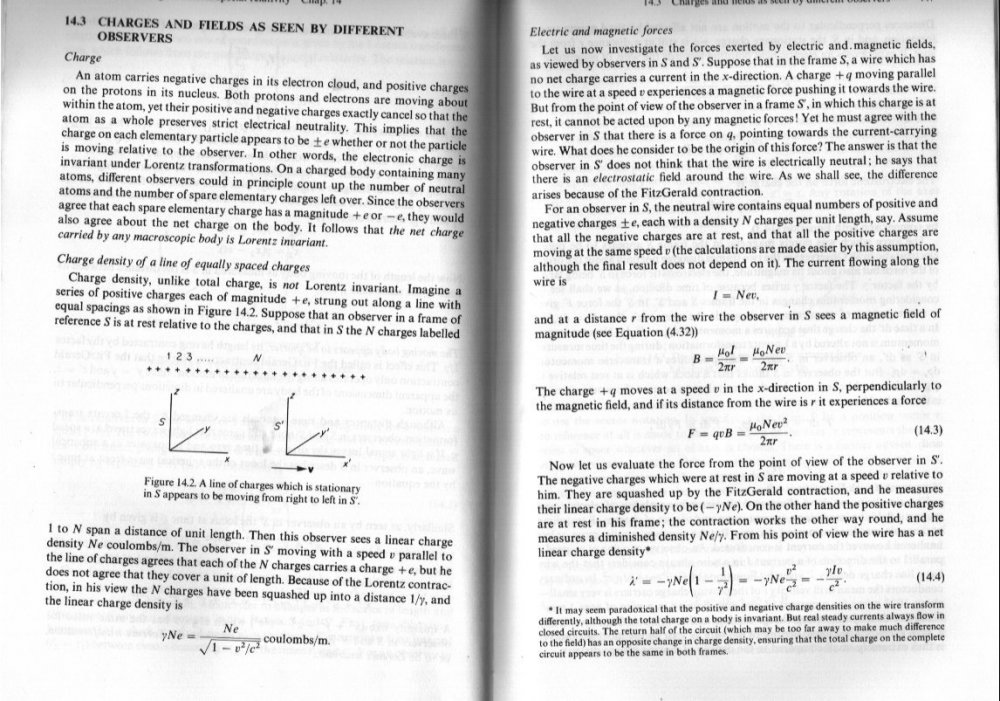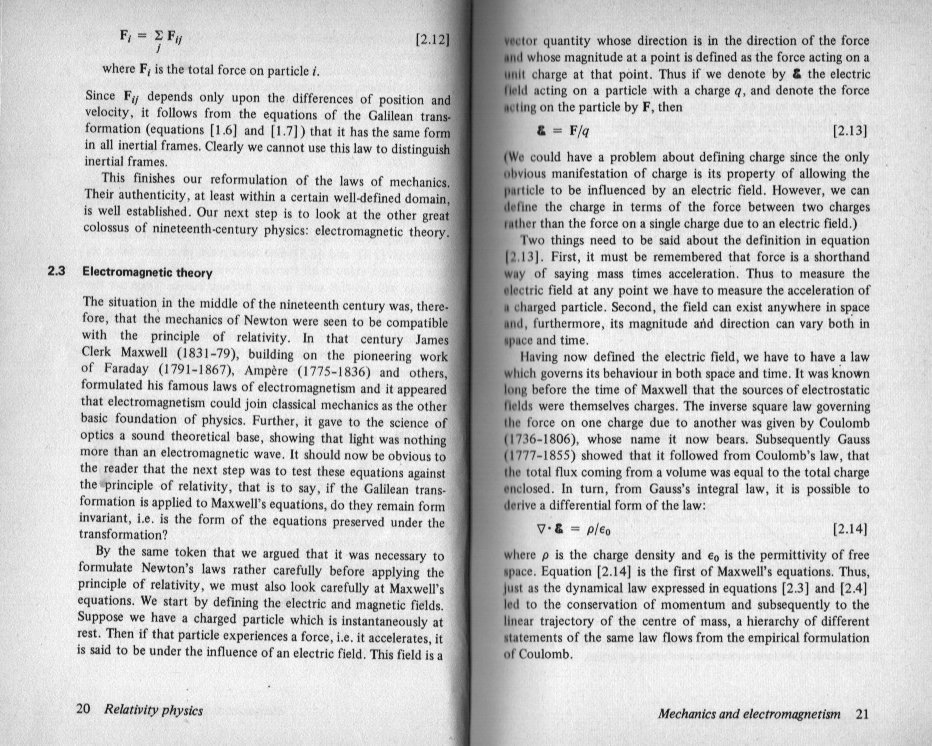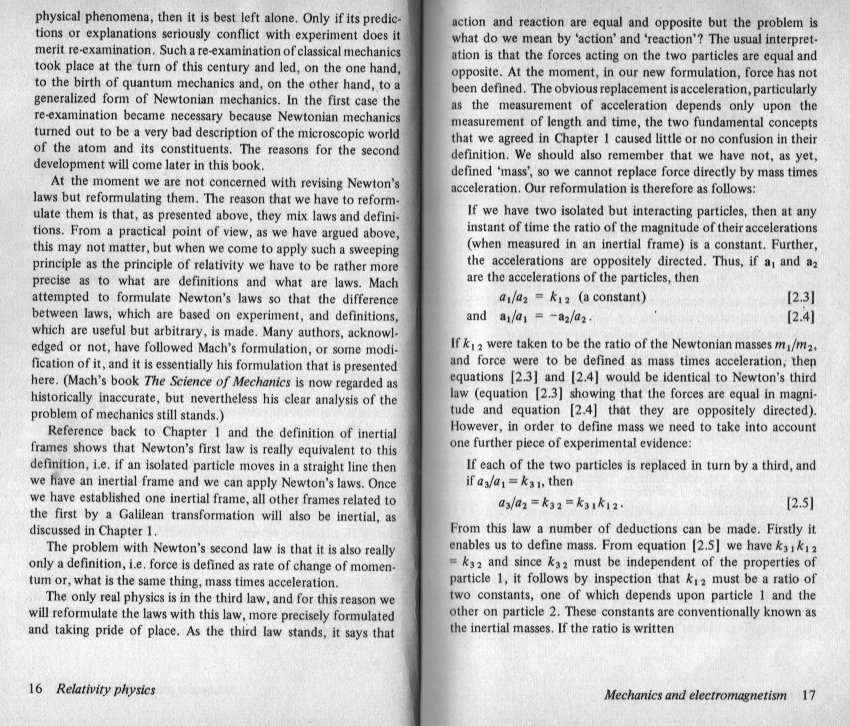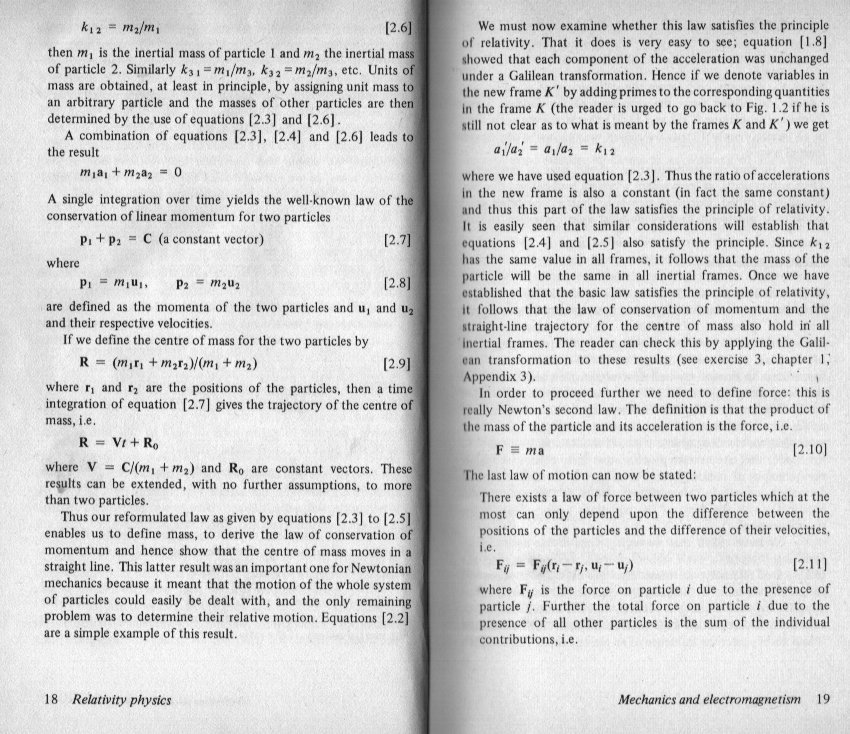-
Posts
18311 -
Joined
-
Last visited
-
Days Won
104
Content Type
Profiles
Forums
Events
Everything posted by studiot
-

FLUIDS (Pressure in a fluid of uniform density
studiot replied to Lizwi's topic in Classical Physics
Timo's posh explanation is just fine but try this simplified one. Looking at the diagram I see that upwards is defined positive. Looking at your equation and the diagram pA - (p+dp) A - ρgAdy So I see that the arrow on the underside is pointing up so pA is positive. But on the top, p and dp point downwards so are negative so (p+dp) is negative on the top dy is positive and g is negative so the third term is also negative. does this help? -

Relativity (split from Can relativity be applied to light speed?)
studiot replied to MPMin's topic in Relativity
Enough pseudomathematics. "more accurately" is a mathematical statement but I see no mathematics. Furthermore the rules here require answers to polite questions and comments from other members -

Relativity (split from Can relativity be applied to light speed?)
studiot replied to MPMin's topic in Relativity
A point is not a frame (hint that is why we have separate words). Besides which the Universe as a whole has no centre. Swansont's reference to a centre was referring to a finite system of bodies not the whole universe. -

Relativity (split from Can relativity be applied to light speed?)
studiot replied to MPMin's topic in Relativity
Well the original question says that the body never experiences a force. But it does not say for how long this period of grace last in the history of the body. I also mentioned momentary conjunctions of the generators of forces acting on the body where the net force is zero. Obviously, in a universe where nothing is moving, no matter how far apart (in space) two bodies are, the 'force field' generated by one will eventually affect the other, though there will be a time lag. The bodies may however be moving so that causal connection comes into play, as Mordred comments. But I would add a rider to his comment that causal connection is not immune from disturbance by a third body which may push something into or out of the connection light cone region. -

Relativity (split from Can relativity be applied to light speed?)
studiot replied to MPMin's topic in Relativity
Thank you for the response, but it is not necessary to consider gravity. Unless the bodies are at exactly the same temperature, there will exist some sort of radiation pressure between them. -

Relativity (split from Can relativity be applied to light speed?)
studiot replied to MPMin's topic in Relativity
I have three points nobody seems to have considered, to add to this discussion. Firstly this idea of a virgin body that has never felt a force. That’s why they might actually be stationary, in other words, no momentum. If an object has experienced a force to make it move surely it has momentum, wouldn’t it make sense to then choose a frame of reference that hasn’t had a force applied to it? Within the bounds aof all known mathematics this requires a single body in an otherwise empty universe. As soon as you introduce more than one body there will always be some sort of force between them. Secondly zero momentum could be momentary (and frame dependant), but the requirement has always been zero net force, not zero force. Thirdly there is no magic in pair production from radiation. -

Maxwell equations vs Lorentz transformation of fields
studiot replied to Danijel Gorupec's topic in Physics
Yes I think it is oft forgotten that relativity acts (directly) only on space and time so affects things only insofar as they link to have a connection to these variables. So for electrodynamics the charges remain the same but the space and tinme interval between them alters, thus altering density (scalar) and rate of change properties (vector). I can post another short extract (from Grant and Phillips) detailing the oblateness you referred to if you like. -

Maxwell equations vs Lorentz transformation of fields
studiot replied to Danijel Gorupec's topic in Physics
Yes I understood that, which is why I asked for more detail. Whenever you have relative motion you must, of necessity, have (at least) two frames. One for each of the objects in relative motion. The rest frame of one of these is chosen as the 'rest frame' and the rest frame of the other, the moving frame. Furthermore the observer's frame also needs some charge to be able to interact with (and thus observe) any fields generated by the moving charge. You have introduced 'relativity'. Have you considered whether the observers in the observer frame will measure the same charge as observers in the frame of the moving charge? This is indeed the case - charge is invariant under the Lorenz transformation so both will agree the value of the charge. However it is variation of charge density that produces the fields. Charge density is not Lorenz invariant so each will measure a different charge density. This is often handled by using Maxwell's equations to introduce what are known as vector potentials. Now Maxwell's equations are (simultaneous) partial differential equations and when we solve them for the fields or potentials we do not obtain unique solutions. Solutions differ by arbitrary (vector) functions. The required solutions are picked out by applying further conditions (boundary conditions) and inparticular what is known as The Lorenz Condition. https://en.wikipedia.org/wiki/Lorenz_gauge_condition Note this is not the Lorenz transformation. Classically this leads to what are known as 'retarded potentials'. When we introduce relativity, it is often easier to use four-vectors than work directly. Here is a simple non four-vector explanation due to Grant and Phillips that may help. Notice their footnote as to how positive and negative charge do not necessarily transform the same under Lorenz. -

Maxwell equations vs Lorentz transformation of fields
studiot replied to Danijel Gorupec's topic in Physics
What do you mean by "the particle is moving in his frame of reference" ? Can you rephrase this properly identifying the frames you wish to employ? -

Best lattice structure/geometry for strength and minimal heat transfer?
studiot replied to Engineer43's topic in Engineering
This is an interesting question to discuss although it is probably too late since you haven't look back since the day after you first posted. I think this is key and I would add to that the question What do is meant by lattice? Does this refer to the physical arrangement of atoms or a truss arrangement of structural components of some sort? Various deductions as to the use can be made from the all too limited information provided, especially since the main load is described as compression / shear, which will be at direct odds with the low thermal conductivity requirement. Various lamination schemes may be proposed to address this, but details will depend upon more complete and exact information being supplied. To others: Is it worth continuing this discussion? -
OK that looks a whole lot better. Hopefully you feel good too since I didn't do it for you, just offered a hint. One small niggle. My calculator says that 35/18 = 1.94 not 1.95. In fact there is no need to work this out at all. Just leave the common acceleration* as [math]\left( {\frac{{35}}{{18}}} \right)[/math] Then you can multiply it all out at the end. Very often something will cancel out and make it even easier. [math]F = ma = 8000*\left( {\frac{{35}}{{18}}} \right)[/math] * Notice also how to spell acceleration.
-
Agreed dimension is not the best word. Yes realm if you like: that is unused. Since you are now listening +1 for encouragement. To carry on the discussion can you tell me what you understand by 'detection' or 'observation' please? These terms do have a specific meaning which roughly corresponds to 'any interaction' with the rest of the universe'. Also you need to discuss boundary conditions when using a wave function.
-
Thank you for this useful reply. What would also be useful would be some feedback about my thoughts on your posts. I really have no idea what you have understood or agreed. Also some idea of the level of maths you can cope with would be useful. You can't do this without some maths. So consider again a simplified 2D x-y system. Now let x = Acos(t) and y = Asin(t) I have used t, since it is conventional. t is known as a parameter or sometimes a running variable. t is used because the running variable is often time. What it does is reduces a 2D system to a 1D system at the cost of introducing conditions by way of the two equations. And time is used to link the (spatial) dimensions as you requested. Conventional time has the same properties as a parameter vaiable. It 'runs' evenly, with no gaps or jumps - the same property as real numbers and the calibration on our x and y axes. But do real objects behave in this manner? Well the East Coast Main (railway) line in Scotland is single track, North of Edinburgh. This means that if an express train is 'stuck' behind a slow train it has to follow at the speed of the slow train. It cannot pass. In fact all the trains on the railway must follow at same speed to avoid collisions. This must also be the case with a single time axis. Everything travels at a constant even rate through the single time axis. Perhaps this is why you have proposed more than one? Of course in space different objects can travel at different speeds without collisions because a faster object can move sideways around a slower one, and also because there are relatively enormous gaps between objects in space. So far as I know we have never observed this type of behaviour involving the single time axis we can observe. In fact it seems choc-a-bloc with objects. I look forward to your comments.
-
You have posted this in homework help for some reason so you need to explain your thoughts or ask a moderator to move it somewhere more appropriate for someone to go through a full derivation with you. I suggest you start with a diagram.
-

Pair production (Electron, positron)
studiot replied to Lizwi's topic in Modern and Theoretical Physics
There is nothing wrong with the law of conservation of mass in the right context. Certainly it should be taught (in context) to high school students. In Chemistry (which you seem to do most) it is the basis of chemical stochiometry (the balancing of chemical equations) It also appears as the Law of Mass Action in Themodynamics, The Continuity Equation in Fluid Mechanics, Conservation of Momentum in classical mechanics. In fact I suspect that a very small percentage of your students will go on to work in disciplines where it does not apply such as sub atomic physics and chemistry, or relativistic physics and chemistry. For the bulk of Science and Engineering it is just fine. -

Newton's 3rd Law and the Relativistic addition of velocities
studiot replied to geordief's topic in Classical Physics
No it hasn't. As they are usually expounded Newton's 3 laws do not concur with Relativity. In particular they do not meet the 'principle of relativity' that physical laws should have the same form in all (inertial) coordinate systems. This treatment by Turner as a reformulation, starting with the 3rd Law, may interest some. Note the comment, at the bottom of page 16, "The only real Physics is in the third law,..." -
You have mentioned several times that you consider a point to have no dimensions. That is indeed the view of the Ancient Greeks (whom you also mentioned) But the Ancient Greeks knew little of trigonometry and nothing of coordinate geometry and later developments in geometry (such as latitude and longitude) and in Physics. So is that view tenable today? Let us explore this, because other respondents here are using dimension in quite a different way, for example:- and Now in both these views, a point has four dimensions (three spatial and one temporal) This is because you require a value for each of Mordred's independent variables. But modern thinking goes much further than this. Consider A point has no volume. But a point can have mass, velocity (a noted by swansont) , spin and many other properties. For every such property the point requires another 'dimension' or alternatively a relationship (such as an equation)to other coordinates. We call these 'generalised coordinates'. Every set of such coordinates form a space. In Physics we call this 'Phase Space'. I have underlined a comment above becasue it is the introduction to a mathematical technique called parametrisation. This is important because Time can be used as a parameter.
-
kg are a measure of mass not weight. Is the net force the same between all parts of the train?
-
I am making a effort to respond to what you say, I hope helpfully. None of your last post responds to mine. In particular I said Now I am just trying to make beter communication between us. Here is an example I think the correct word here is a region of space. 'Area' has a particular specialist meaning in Science and I do not think you mean that. Before you asked specifically about the relationship or the connection between the coordinate axes (if any) and I am trying to work through that. But I am receiving no indication if you are following this or not. When we have laid the groundwork I propose to explore your very interesting suggestion that travelling (I won't call it motion or movement as they again has specific meanings in Science) in time requires multiple time dimensions. But can we lay that aside until we have discussed axes, dimensions and the relationships between them first?
-
A very good question. In order to discuss this let us try to simplify and just use x;y coordinates for the moment. Are these unique representations? No they are not, but they have certain desirable characteristics. Notably that the physical dimensions of x and y are the same. So when we consider a (differential) variation with time, these differentials have the same form of physical dimensions (they are both velocities) [math]\dot x = \frac{{dx}}{{dt}};\dot y = \frac{{dy}}{{dt}}[/math] This allows us to combine the two to form a vector describing the overall change over time. That is they are the components of that vector. BUT CONSIDER If we use polar coordinates, r and θ then these refer to the same point and their time derivatives to the same change but they do not have the same physical dimensions. [math]\dot r = \frac{{dr}}{{dt}};\dot \theta = \frac{{d\theta }}{{dt}}[/math] So we cannot combine these directly to establish the overall change. The angular derivatives are not components of a vector. I see you are in a very different time zone from myself so I guess that English is not your first language. If this is true we can help you choose the correct English words for what you want to say. Just ask.
-
No would you elaborate. Also thank you for having a genuine conversation with me. A vector space is a mathematical generalisation of the idea of a plot or graph with axes and a function connecting or detailing (your explaining?) the relationship between the axes. In this terminology, the axes are called 'basis vectors'. In truth they are just lines like any other lines on the graph and we could plot the graph relative to any pair of non parallel lines.
-
Thank you. This suggests (to me) you are trying to describe some sort of vector space as the construct. Are you aware of the conventional rules relating to vector spaces vis a vis dimensions and bases ?
-
When I last went to school they taught that a question was signified by placing a question mark at the end. Is this no longer the case? However I'm glad you consider it a good question and since this is your thread what is your definition of a dimension? I don't wish to argue with you over definitions, just to understand the context in which you are employing the term in order to reply in that context


